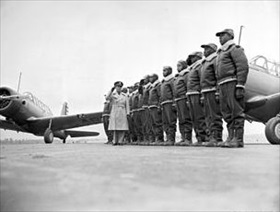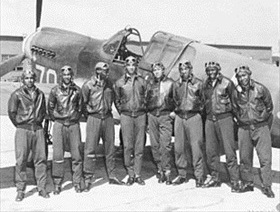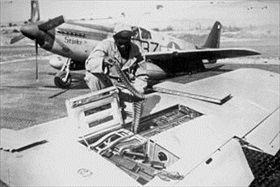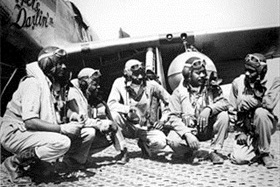CIVILIAN PROGRAM TO BOOST PILOT NUMBERS
Washington, D.C. • December 27, 1938
In 1938 America’s armed forces had less than 3,000 professional pilots. To speed the production of pilots outside the U.S. armed services, President Franklin D. Roosevelt unveiled the Civilian Pilot Training Program (CPTP) on this date in 1938. The program was intended, the president said, to provide a boost to general aviation by offering pilot training to 20,000 college students a year. Its potential for national defense was unstated but undisguised, especially since Nazi Germany and Fascist Italy had begun training thousands of young people to become pilots in government-sponsored programs at what were military flight training academies.
Participants in Roosevelt’s CPTP program, renamed the War Training Service (WTS) after the Japanese surprise attack on the U.S. Pacific Fleet at Pearl Harbor, Hawaii, on December 7, 1941, agreed to enter the military after successfully completing flight training. At its peak, 1,132 educational institutions and 1,460 flight schools produced aviation cadets—men and women both—though not without risk to both students and instructors: 18,000 people lost their lives in stateside training accidents during the program, and many thousands of planes were damaged or destroyed.
Teaching college students to fly greatly augmented the number of pilots available to the U.S. armed forces. The inclusion of Alabama’s Tuskegee Institute in the ranks of CPTP participants (see accompanying story), along with Hampton Institute, Virginia State University, and Howard University, helped open the doors for the first African American military pilots. It was a war-winning combination all around.
Along with the U.S. Army and U.S. Navy training programs, the civilian flight training program produced more than enough qualified pilots—435,165 men and women, including astronaut John Glenn and Senator George McGovern—while at its 1944 peak American industry produced 96,000 aircraft, up from a little more than 6,000 in 1940. The U.S. military alone purchased a quarter of a million warplanes during the war. (In 1938 the U.S. arsenal of aircraft numbered just over 4,000, while Germany had between 5,000 and 10,000 planes with an annual production capacity of 12,000 and Italy 3,000 with an annual capacity of 2,400 planes.) By 1944 Germany and Japan had lost many of their best pilots and never recovered, and their aircraft production too was out-produced by U.S. manufacturers (Ford Motor Company built a complete 4‑engine B‑24 Liberator every hour at its huge Willow Run, Michigan, facility)—to say nothing of warplanes churned out by aircraft manufacturers in Canada, Great Britain, and the Soviet Union. The unprecedented expansion of America’s military aviation capabilities made an American, and an Allied, victory inevitable.
Tuskegee Airmen, the First African American Military Aviators in the U.S. Armed Forces
 |  |
Left: Maj. James A. Ellison reviews the first class of Tuskegee cadets and the flight line at the U.S. Army Air Corps basic and advanced flying school, Tuskegee, Alabama, 1941.
![]()
Right: Tuskegee Airmen, circa May 1942 to August 1943. Location unknown but likely Southern Italy or North Africa.
 |  |
Left: 99th Fighter Squadron mechanic reloading a P‑51 Mustang, September 1944. The 99th Fighter Squadron (originally, 99th Pursuit Squadron) was America’s first all-black flying unit and was commanded by Lt. Col. Benjamin O. Davis, Jr. Davis next assumed command of the 332nd Fighter Group, another all-black flying unit, whose mission was escorting American B‑17 Flying Fortresses and B‑24 Liberators to Axis targets in Southern Europe and Germany. Davis himself flew 60 missions in Bell P‑39 Airacobras, Curtiss P‑40 Warhawks, Republic P‑47 Thunderbolts, and North American P‑51 Mustangs.
![]()
Right: Pilots of the 332nd Fighter Group at Ramitelli Pilots of the 332nd Fighter Group at Ramitelli Airfield (part of the Foggia Airfield Complex in Italy’s southeast), August 1944. Left to right: Lieutenants Dempsey W. Morgan Jr., Carroll S. Woods, and Robert H. Nelson Jr., Capt. Andrew D. Turner, and Lt. Clarence P. Lester, who had 3 enemy fighters to his credit. Formally the 99th Fighter Squadron formed the 332nd Fighter Group and the 477th Bombardment Group of the U.S. Army Air Forces. They were known as “Red Tails” for the distinctive designs on their planes; they earned the nickname “Red Tail Angels” with their reputation for staying with the bomber planes they escorted. By the end of the war, the Red Tails had destroyed some 260 Axis aircraft in the air and on the ground while losing 32 of their own. It was an outstanding record, and it earned the 332nd Fighter Group a Distinguished Unit Citation.
Contemporary U.S. Army Air Forces’ Tribute to Tuskegee Airmen
![]()

 History buffs, there is good news! The Daily Chronicles of World War II is now available as an ebook for $4.99 on Amazon.com. Containing a year’s worth of dated entries from this website, the ebook brings the story of this tumultuous era to life in a compelling, authoritative, and succinct manner. Featuring inventive navigation aids, the ebook enables readers to instantly move forward or backward by month and date to different dated entries. Simple and elegant! Click
History buffs, there is good news! The Daily Chronicles of World War II is now available as an ebook for $4.99 on Amazon.com. Containing a year’s worth of dated entries from this website, the ebook brings the story of this tumultuous era to life in a compelling, authoritative, and succinct manner. Featuring inventive navigation aids, the ebook enables readers to instantly move forward or backward by month and date to different dated entries. Simple and elegant! Click 











